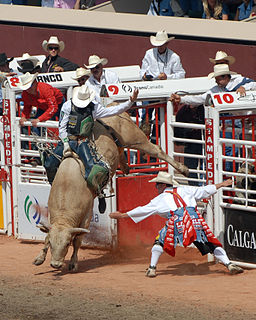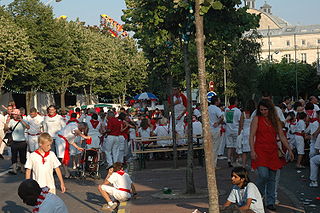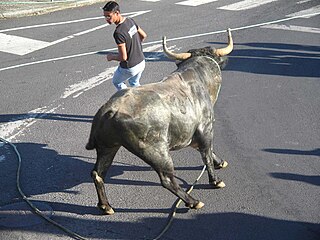 W
WBovine sports are sports that involve cattle, commonly a bull, ox, steer, cow or calf.
 W
WBucking is a movement performed by an animal in which it lowers its head and raises its hindquarters into the air while kicking out with the hind legs. It is most commonly seen in herbivores such as equines, cattle, deer, goats, and sheep. Most research on this behavior has been directed towards horses and cattle.
 W
WA bucking bull is a bull used in American rodeo bull riding competition. They are usually a Brahman crossed with another breed, weighing 1,500 pounds or more, selected for their tendency to "leap, plunge and spin" when a human is on its back. Circa mid-20th century breeders began selecting bulls for bad temperament, that would buck when ridden. Many of the best bucking bulls trace their lineage to bulls owned by Charlie Plummer of Oklahoma. These are known as Plummer bulls.
 W
WBull running was a medieval custom practised in England until the 19th century. It involved chasing a bull through the streets of a town until it was weakened, then slaughtering the animal and butchering it for its meat. Bull running became illegal in 1835, and the last bull run took place in Stamford, Lincolnshire, in 1839. The practice was not confined to any particular region, with bull runs also documented at Axbridge in the south west, Canterbury and Wokingham in the south east, Tutbury in the midlands, and Wisbech in the east.
 W
WBull wrestling, cow fighting or bull fighting is a non-lethal bloodsport between bulls or cows found in some parts of the world.
 W
WBull-baiting is a blood sport involving pitting a bull against another animal, usually a dog.
 W
WBull-leaping is a term for various types of non-violent bull fighting. Some are based on an ancient ritual from the Minoan civilization involving an acrobat leaping over the back of a charging bull. As a sport it survives in modern France, usually with cows rather than bulls, as course landaise; in Spain, with bulls, as recortes and in Tamil Nadu, India with bulls as Jallikattu.
 W
WA corraleja is a bullfighting festival in the Caribbean region of Colombia. In this type of event, the public is invited to engage the bulls in the ring. Compared a Spanish-style bullfight, the bulls are not killed after the fight, and the event is much less formal.
 W
WA feria is an annual local festival in Spain and southern France, characterized by bullfights, bull running in the streets, bodegas and bandas. The word festayre means ferias' partiers.
 W
WThe Professional Bull Riders, Inc. (PBR) is an international professional bull riding organization based in Pueblo, Colorado, United States. In the United States, PBR events have been televised on CBS and CBS Sports Network since 2012. In 2013, the PBR and CBS signed a contract that extended CBS Sport's partnership with PBR, making them the primary sports broadcaster for PBR. In 2018, the PBR launched RidePass; its own subscription-based video on demand service that live-streams PBR events, as well as PBR-produced events for other western sport organizations. On July 20, 2021, RidePass switched from a subscription-based streaming service to a free, ad-supported streaming channel on Pluto TV. More than 600 cowboys from the United States, Canada, Mexico, Brazil, Australia and other countries hold PBR memberships.
 W
WA running of the bulls is an event that involves running in front of a small group of bulls, typically six but sometimes ten or more, that have been let loose on sectioned-off streets in a town, usually as part of a summertime festival. Particular breeds of cattle may be favored, such as the toro bravo in Spain, also often used in post-run bullfighting, and Camargue cattle in Occitan France, which are not fought. Bulls are typically used in such events.
 W
WThe Stamford bull run was a bull-running and bull-baiting event in the English town of Stamford, Lincolnshire. It was held on St Brice's Day, for perhaps more than 600 years, until 1839. A 1996 Journal of Popular Culture paper refers to the bull run as a festival, in "the broader context of the medieval if not aboriginal festival calendar", though works written during and shortly after the activity's later years variously describe it as a "riotous custom", a "hunt", an "old-fashioned, manly, English sport", an "ancient amusement", and – towards its end – an "illegal and disgraceful ... proceeding".
 W
WTōgyū (闘牛) also known as ushi-zumo or Bull sumo, is a spectator sport native to the Ryukyu Islands of Japan. It is also held in other regions of Japan, such as Iwate Prefecture, Niigata Prefecture, Shimane Prefecture, and Ehime Prefecture. Although sometimes known to Westerners as "Okinawan bullfighting", it is drastically different from the Spanish or Portuguese style of bullfighting where the matches are between a bull and a human, with blood being spilt. Tōgyū has more in common with northern Portugal's sport of chegas and the Swiss sport of cow fighting.
 W
WThe Toro de la Vega is a Spanish medieval bull festival and tournament celebrated in the town of Tordesillas in Valladolid, Spain. The tournament consists of hundreds of lancers chasing – either by foot or on horseback – a bull through town streets, corralling it into an open area. Once the bull has been drawn out away from town, it is killed by spearing. The tournament follows a series of strict rules and procedures dating back to the mid 16th century.
 W
WA toro embolado, bou embolat, roughly meaning 'bull with balls', is a festive activity, typical of many towns in Spain, in which a bull that has burning balls of flammable material attached to its horns is set free in the streets at night, and participants dodge the bull when it comes close. It can be considered a variant of an encierro. This activity is held in a number of Spanish towns during their local festivals. In the 21st century animal welfare activists have attempted to stop this practice as cruel.
 W
WTourada à corda, toirada à corda or corrida de touros à corda, is a type of bullfighting traditional to the Azores Islands, and particularly the island of Terceira, where it is believed to be one of the most ancient recreational traditions in the archipelago.
 W
WThe Tutbury bull run was a blood sport that took place in Tutbury, Staffordshire, from the 14th century until 1778. It formed part of the annual Court of Minstrels, a ceremonial legal proceeding for travelling musicians in the nearby counties. The Tutbury bull run is first recorded in 1414 but may be of earlier origin, though a story that it was begun by John of Gaunt to remind his Spanish wife of home is believed false. The bull was provided to the minstrels by Tutbury Priory and, after the Dissolution of the Monasteries, by the Duke of Devonshire. The bull would be chased through the town by the minstrels who could claim it if it was caught. It was afterwards baited to death and served in a feast. The event developed into a competition between Staffordshire and Derbyshire residents who competed to catch the bull within their own counties. After the decline of the Court of Minstrels the bull run developed into a drunken revel. It was abolished in 1778 after a man was killed during a mass brawl.